Departure Date: October 18 - 25, 2025
Compiled By: Barry Zimmer
Trip Leaders: Barry Zimmer, Local Leader
Toll Free: 800.328.8368
Phone: 512.328.5221
Fall at Panama's Canopy Tower 10/18/2025-10/25/2025

https://ebird.org/tripreport/428094
Our trip began at treetop level with a morning watch atop the Canopy Tower observation deck. In the pre-dawn darkness, the Morse code hoots of the Rufous Motmot and the ethereal calls of Great Tinamou drifted up from the forest below and marked the beginning of a new day.
I poured my first cup of coffee as the first hints of gray were forming on the horizon. Our group was beginning to assemble, and birds were beginning to move. A Lesser Nighthawk sailed over the tower, our first bird of the tour! Neotropical migrants were already filtering through the tree tops—a Blackburnian Warbler appeared first and was quickly followed by a Bay-breasted Warbler and then a Red-eyed Vireo. Brown-capped Tyrannulets were singing, and with some coaxing, one almost landed on the tower railing. By following its croaking calls, a distant Keel-billed Toucan was spotted on a bare tree. The variety of song in the canopy grew rapidly as the light improved—a Green Shrike-Vireo began to sing, Yellow-throated Toucans yelped in the distance, and a persistent Bright-rumped Attila ushered in the new day. A pair of Mealy Parrots was spotted flying by one side of the deck, and then at almost the same time, a troop of adorable Geoffroy’s Tamarins appeared just below eye level on the other side. The tamarins came in quite close, waiting for their morning banana feeding. A group of Scaled Pigeons rocketed past and were quickly followed by a small cluster of Brown-hooded Parrots. I had completely lost track of my coffee long ago, so I poured a new cup. At that moment, a Black-breasted Puffbird arrived and posed well just below eye level. Moments later, a handsome Squirrel Cuckoo appeared in a nearby bare tree. Just then, Alex spotted a Semiplumbeous Hawk perched up in the valley below us. The Bright-rumped Attila continued to sing quite close, but it seemed to be hiding. Where was it? More important, where was my coffee? Each time a new bird was spotted, the coffee was sat down somewhere. Spiraling around the observation deck, chasing after new sightings, meant losing track of each cup quickly. Half-full cups were scattered about the tables on the deck in haphazard manner. Lesser Greenlet, Golden-hooded Tanager, Scarlet Tanager, Crimson-crested Woodpecker—new birds kept appearing at a regular pace. A Mantled Howler Monkey with its tiny new baby settled in the treetops at eye level allowing wonderful studies, and a seemingly out-of-place Magnificent Frigatebird sailed over the jungle. Finally, someone from the kitchen appeared at the top of the stairs and announced breakfast was ready. I could tell this was going to be a good trip!
We gulped down our breakfast and headed straight back up to the top. We remained on the observation deck for about another hour or so, tallying several new birds, including a great variety of raptors—a Snail Kite (rare from the tower), a dark morph Hook-billed Kite, a distant Black Hawk-Eagle, a pair of Great Black Hawks, a light morph Short-tailed Hawk, two Crane Hawks, and several small kettles of Broad-winged Hawks.
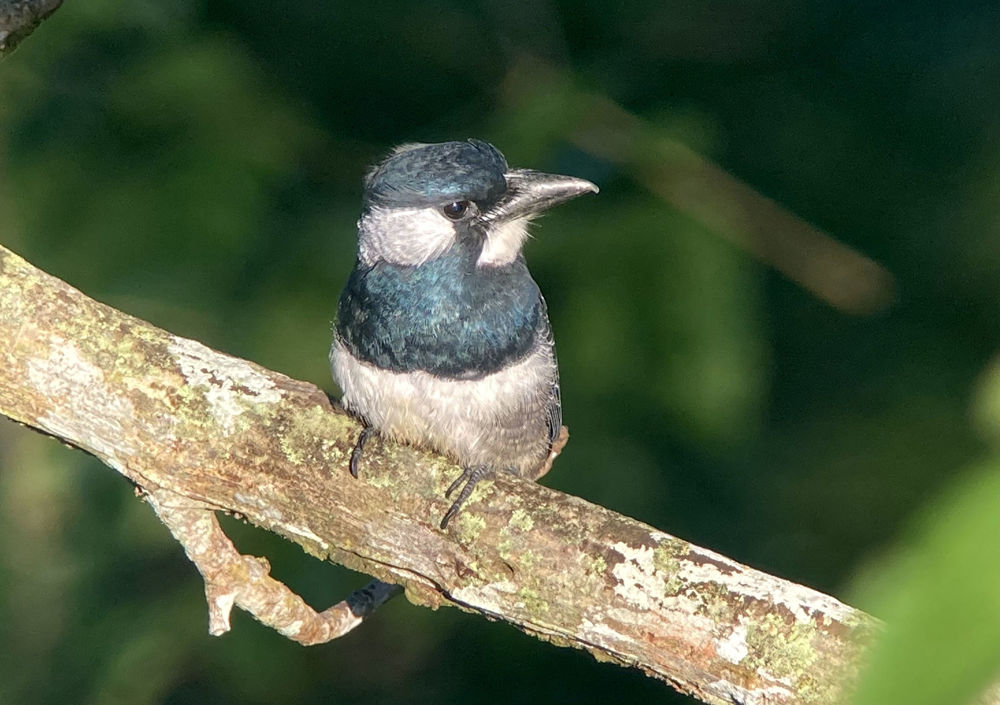
Black-breasted Puffbird, Canopy Tower, Panama, October 19, 2025, ©Barry Zimmer
By 9:40 or so, we opted to walk down Semaphore Hill along the tower entry road. First though, we paused at the hummingbird feeders at the bottom of the tower. Six species of hummingbirds were swarming about the feeders, including Blue-chested, stunning Violet-bellied, Snowy-bellied (with their white pantaloons), White-necked Jacobin, White-vented Plumeleteer, and a couple of Long-billed Hermits. Being mid-morning, things had quieted down quite a bit as we strolled downhill, but we quickly found an unusually cooperative White-breasted Wood-Wren and a female Black-crowned Antshrike. The remainder of our walk yielded such goodies as a pair of Broad-billed Motmots, Gartered Trogon, Cinnamon Woodpecker, Yellow-throated Toucan, and Green Shrike-Vireo among others.
Lunch and a mid-afternoon break ensued. Some of us opted to bird from the observation deck during the break. We were rewarded with a very close female Blue Cotinga, perched Brown-hooded Parrots, a pair of Yellow-throated Toucans, and nine Keel-billed Toucans in view at once!
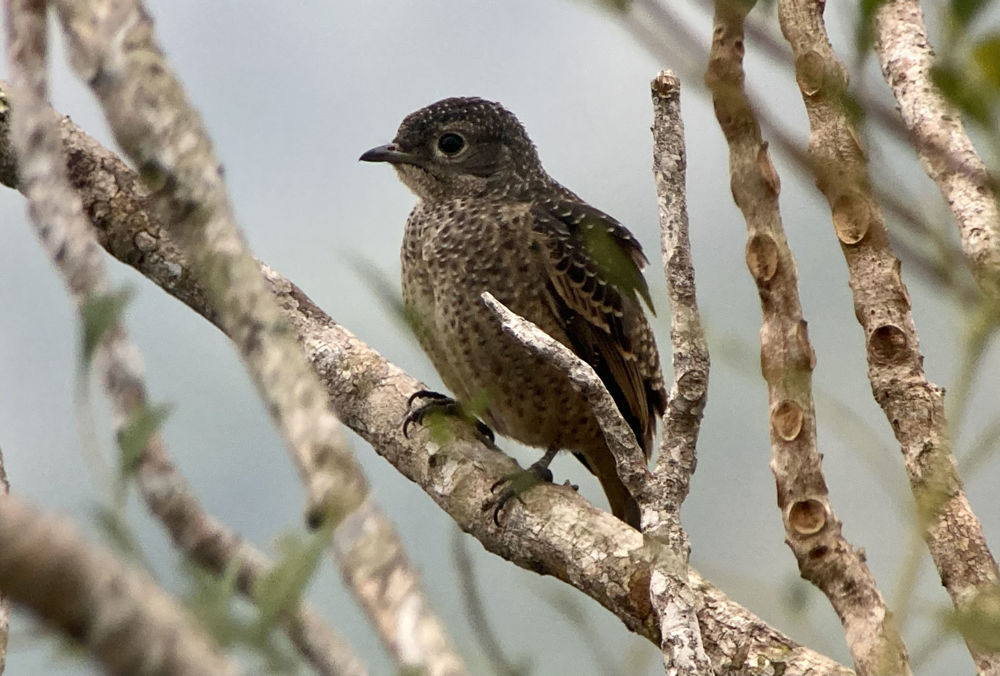
Blue Cotinga, Canopy Tower, Panama, October 19, 2025, ©Barry Zimmer
At 3 PM, we headed down to the Canopy B&B in Gamboa, where we filled the tray feeders with bananas and were quickly inundated with birds. Blue-gray and Palm tanagers came in almost immediately and were quickly followed by a long list of birds representing pretty much every color of the kaleidoscope. Gray-headed Chachalaca, Whooping Motmot, Rufous Motmot, Red-crowned Woodpecker, Clay-colored Thrush, Red-legged and Green honeycreepers, Plain-colored Tanager, and incomparable Crimson-backed Tanagers all appeared, and no more than twenty feet away! Rufous-tailed Hummingbirds flitted about the garden, and cute Central American Agoutis scurried about on the ground.
We had just enough time for one more stop, so we headed over to the nearby Ammo Dump ponds. Wattled Jacana, Purple Gallinule, Southern Lapwing, wonderful Barred Antshrikes (so metal), Rusty-margined and Social flycatchers, and Cinnamon and White-winged becards were among the more interesting additions. Just before dinner, we checked the banana feeder outside the dining room window of the tower, and in short order we saw Derby’s (Central American) Woolly Opossum no more than ten feet away.
Finally, the first day of our trip was over. We had tallied an impressive 105 species for the day and still had five more days of birding to go. A week at the Canopy Tower really is hard to top!

Red-legged Honeycreeper, Canopy B&B, Panama, October 19, 2025, ©Barry Zimmer
Day Two found us back at the Ammo Dump ponds briefly, before we headed out to the beginning of Pipeline Road. White-throated Crakes were calling in the marsh, but we almost never actually see these phantoms. On this day, however, we actually had three sightings of a crake in full view for a few seconds each time. What a treat!
We spent the bulk of the day birding the first several kilometers of Pipeline, as far as the Juan Grande bridge. We had excellent luck with several very uncommon to rare species. Topping the list was a Speckled Mourner right overhead at our first stop, followed in short order by point-blank views of a Scaly-throated Leaftosser! A family group of Song Wrens gave excellent views, as did a pair of dapper Spotted Antbirds. A Streak-chested Antpitta started singing its somewhat mournful song, but we were unable to see this skulking ground dweller on this day. Four species of trogons, three species of motmots, Checker-throated Stipplethroat, White-flanked Antwren, Dot-winged Antwren, Bicolored Antbird, Yellow-backed Oriole, and Gray-headed Tanager—our list was growing at a rapid pace. Pipeline Road is truly a birder’s paradise!

Scaly-throated Leaftosser, Pipeline Road, Panama, October 20, 2025, ©Barry Zimmer
The next day, we returned to Pipeline Road to explore the adjacent Panama Rainforest Discovery Center (and its accompanying tower). A trio of White-necked Puffbirds at the beginning of Pipeline Road got our morning off to a great start. We were quickly greeted by Chestnut-backed Antbirds in the PRDC parking area—it was Beth’s 1000th world bird! A Yellow-rumped Cacique posed right over our heads, while Scarlet-rumped Caciques and three stunning Black-striped Woodcreepers were sighted around the base of the tower. We did an hour and a half vigil atop the PRDC tower that was somewhat slow overall but did produce Lesser Swallow-tailed and Short-tailed swifts, a nice flight of Swainson’s Hawks, and two adult King Vultures that slowly sailed right over our heads (thanks Pam!). Incredibly, on our way out, a Great Tinamou was just sitting in the middle of the road sun-bathing. Tinamous are often heard but seldom seen, so this was a prized and unexpected sighting. Alex knew of a spot where Great Potoo sometimes roosts along the highway on our way back. Luck was on our side, as the bird was present, and we enjoyed prolonged scope studies of this strange species. Just before we got back to the Canopy Tower, we found a White-whiskered Puffbird perched over the entry road—a great ending to a great morning!
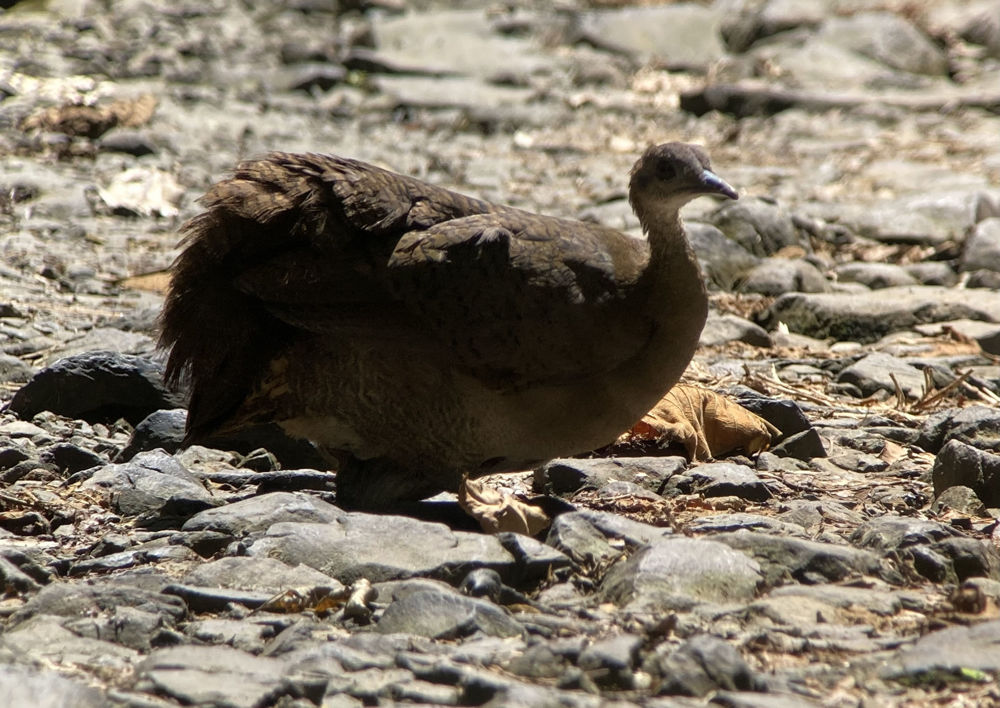
Great Tinamou, Pipeline Road, Panama, October 21, 2025, ©Barry Zimmer
That afternoon found us at the Gamboa marina and Gamboa Rainforest Reserve. We added many good birds in short order including point-blank Snail Kite, Gray-lined Hawk, Lesser Kiskadee, Common Tody-Flycatcher and Mangrove Swallow at the marina, and a totally unexpected Ruddy Quail-Dove (Eddie’s 700th bird!), Southern Rough-winged Swallow, Buff-breasted Wren, and a bonus Tamandua (Lesser Anteater) in the reserve. At dinner, we had great looks at two Kinkajous coming in to the bananas outside the dining area.
Day Four took us to a completely different habitat in the foothills of Cerro Azul and Cerro Jefe. Topping out at an elevation just over 3,000 feet, the foothills birding gave us access to a host of new species. We began on a trail through the forest at Cerro Jefe. A small group of Black-and-yellow Tanagers and a Scale-crested Pygmy-Tyrant were found in the parking area. A short hike up the trail itself yielded an absolutely stunning Rufous-winged Tanager (generally rare), in addition to Spotted Woodcreeper, White-ruffed Manakin, Golden-hooded Tanager, Slate-colored Grosbeak, and White-vented Euphonia. A walk through an adjacent residential area produced Violet-headed and Violet-capped hummingbirds, Chestnut-capped Warbler, Black-striped Sparrow, and two brilliant Emerald Tanagers.

Rufous-winged Tanager, Cerro Jefe, Panama, October 22, 2025, ©Barry Zimmer
Just before lunch (and a huge downpour), we reached a nearby private residence (sometimes referred to as the “hummingbird house”). There we enjoyed one of the most amazing feeder shows on the planet, which included eight species of hummingbirds (we estimated a staggering 200+ individuals), three species of honeycreepers, and a couple of tanagers—all just feet away. We added Bronze-tailed Plumeleteer and Green Hermit to our hummingbird list, as well as stunning Shining Honeycreepers (abundant), Bay-headed (pair feeding a baby) and Hepatic tanagers, and Yellow-faced Grassquit. Thank you, Jerry and Linda!
The next morning found us back on Pipeline Road searching for any species we had previously missed. We went directly to the spot where we had heard the Streak-chested Antpitta a few days back, and once again it was singing some distance into the forest. Despite some effort, we were unable to coax it in any closer, so Alex looked for a path for us to get to the bird. Within a few minutes, he had spotted the bird singing on the ground. We crept into the forest single file and were able to get both scopes on this wonderful bird. We watched it sing for almost ten minutes, as its body expanded and contracted like bellows. It was an awesome trip highlight for everyone. Other morning highlights along Pipeline included two more seen Great Tinamous, White-whiskered Puffbird from fifteen feet, Collared Aracari, wonderful views of a Black-faced Antthrush, Plain-brown Woodcreeper, Northern Plain-Xenops, a pair of Dot-winged Antwrens building a nest, Black-bellied Wren, and Purple-throated Fruitcrow. On our way back to the tower, we stopped briefly at the Ammo Dump ponds again and added a Muscovy Duck and an American Pygmy Kingfisher to our list.
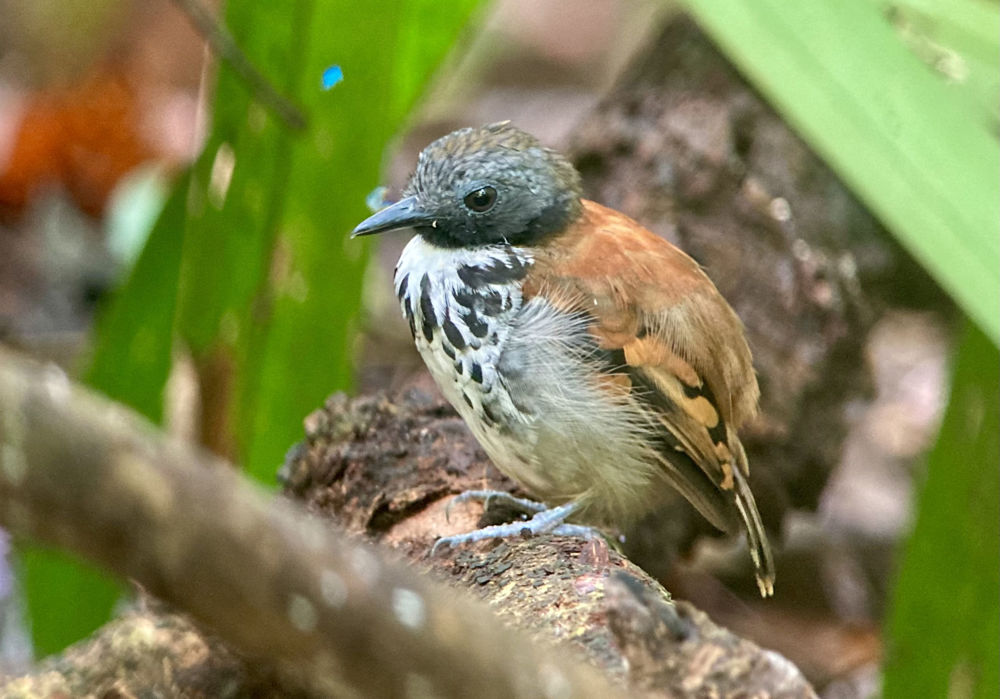
Spotted Antbird, Pipeline Road, Panama, October 23, 2025, ©Barry Zimmer
During the post-lunch break, three Brown-throated Three-toed Sloths, including a mother with a tiny baby, really put on a show during this time as well.
In the afternoon, we went down to Old Gamboa Road and the Summit Ponds. The ponds were particularly productive. Roosting Boat-billed Herons (including a baby on a nest), Amazon and Green kingfishers, Orange-chinned Parakeets excavating a nest hole, Prothonotary Warbler, and American Crocodile were most noteworthy. A walk through the nearby forest produced the uncommon Jet Antbird and a bathing Velvety Manakin.
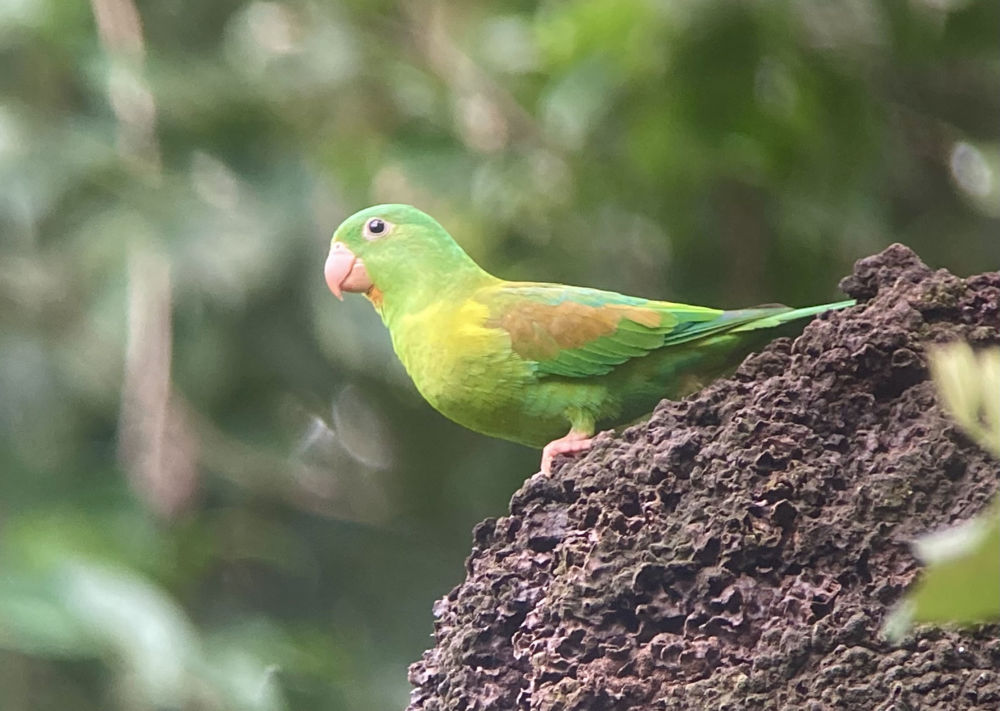
Orange-chinned Parakeet, Summit Ponds, Panama, October 23, 2025, ©Barry Zimmer
On our last day, we visited Metropolitan Park in Panama City. Best birds here included Dusky and White-bellied antbirds, a male Lance-tailed Manakin, Black-chested Jay, Golden-fronted Greenlet, great looks at Rufous-breasted and Rufous-and-white wrens, Long-billed Gnatwren, and Red-crowned Ant-Tanager. Heading back to the tower for lunch, we noticed a sizable kettle of migrating raptors over Panama City. Then we saw more flowing into that kettle. We were trapped in traffic, and it seemed there was no way to stop. The more we looked, the more raptors we saw. Finally, I said, “we have to get out and see this.” A quick u-turn took us into a mall parking lot, where everyone jumped out and stared up at the sky in amazement. The number of birds was staggering, filling every corner of the sky. Although it was very difficult to estimate accurately, I thought we were watching a quarter million birds pass over us. The majority were Swainson’s Hawks, but there were large numbers of Turkey Vultures and smaller numbers of Broad-winged Hawks as well. It was an incredibly moving experience, with multiple people telling me afterwards that it brought them to tears. It was arguably the greatest natural history experience any of us had ever seen in our lives. This raptor migration was ultimately voted the “favorite bird of the tour” by the group that evening.
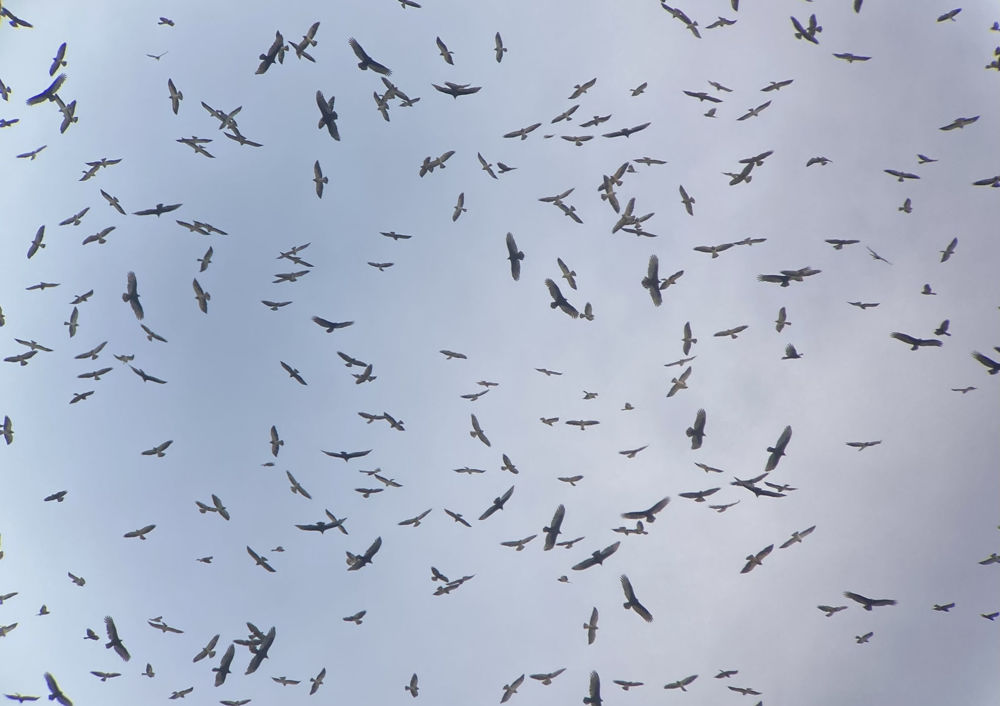
Raptor migration, Panama City, Panama, October 24, 2025, ©Barry Zimmer
In the afternoon, most of the group visited the Miraflores Locks at the Canal to see a ship transit the locks and watch a movie on the history of the Canal. It was a fitting ending to our trip.
In all, we tallied an impressive 259 species of birds and 18 species of mammals in our week at the tower. We had generally good weather overall, with the rain factoring in only a few times for brief periods. Special thanks to Alex Sanchez for his invaluable leadership. I can’t wait to return next year!
A complete list of the birds recorded on our tour can be found at: https://ebird.org/tripreport/428094
Description for the next departure of this tour.
Barry Zimmer's upcoming tour schedule.
ITINERARY:
October 18 – arrival at the Canopy Tower in the evening
October 19– observation deck of tower until 9:40 AM, hummingbird feeders, Semaphore Hill; afternoon to Gamboa (Canopy B and B) and Ammo Dump ponds (105 species; 105 species total)
October 20 – Ammo Dump Ponds briefly, Pipeline Road to the Juan Grande bridge; late afternoon tower watch (79 species; 145 total)
October 21 - Pipeline Road to Panama Rainforest Discovery Center (PRDC), including the Panama Rainforest Discovery Center itself and tower; Omar Torrijos Highway; afternoon to Gamboa Rainforest Reserve and marina, Canopy B and B (105 species; 172 total)
October 22 – Cerro Azul (including the “hummingbird house” of Jerry & Linda Harrison) and Cerro Jefe; Panama Viejo mudflats (102 species; 236 total)
October 23 –Pipeline Road to the Juan Grand bridge, Ammo Dump ponds; mid-day tower watch; Old Gamboa Road and Summit Ponds in the afternoon; evening night drive down Semaphore Hill (118 species; 242 total)
October 24 - Metropolitan Park; optional visit to Miraflores Locks in the afternoon for some, tower watch for others (53 species; 259 total)
October 25 – departures for home (259 species total)




